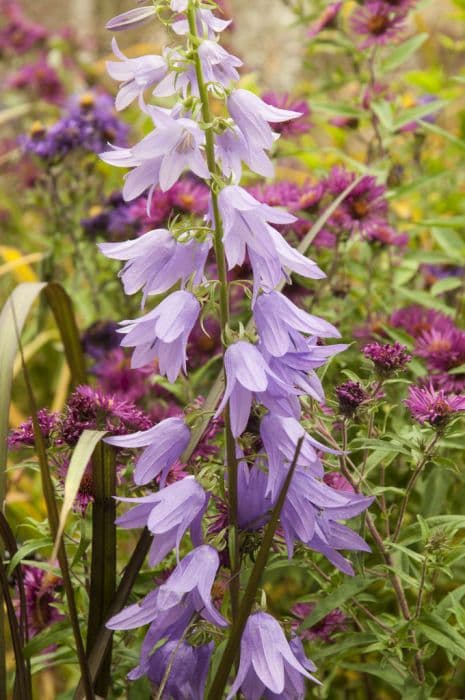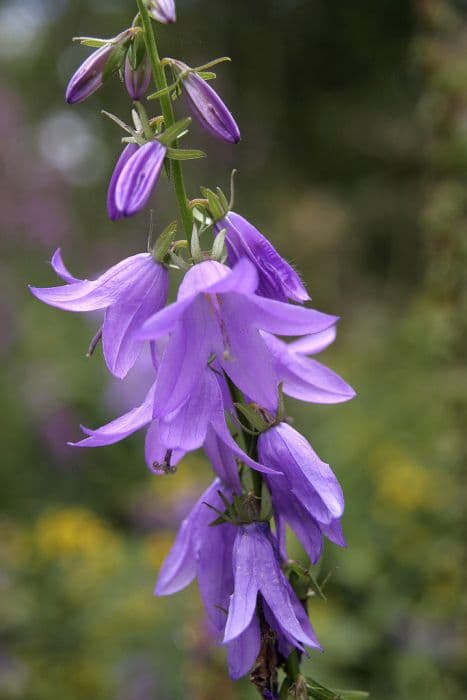Rock Isotome Isotoma axillaris

ABOUT
Isotoma axillaris, commonly known as rock isotome, boasts a lush and delicate appearance. This plant is characterized by its small and star-shaped flowers, which display a vivid blue hue, often with a touch of lighter blue or white in the center. These flowers give it a charming and dainty look, making it a favorite in gardens. The foliage of rock isotome is also noteworthy, consisting of slender, green leaves that can sometimes have a slightly serrated edge, adding texture and depth to its overall appearance. The plant has a spreading habit, forming a mat-like presence that gracefully covers the ground, providing an enchanting ground cover that bursts into a sea of blue when it blooms. The overall aesthetic of rock isotome is that of a delicate and whimsical plant, drawing the eye with its fairy-like blossoms and creating a soft, romantic effect wherever it grows.
About this plant
 Names
NamesSynonyms
Rock Isotome, Showy Isotome, Blue Star Flower
Common names
Laurentia axillaris, Isotoma fluviatilis subsp. australis, Isotoma fluviatilis var. australis, Isotoma petraea, Isotomes fluviatilis, Solenopsis axillaris.
 Toxicity
ToxicityTo humans
Blue star creeper, or Isotoma axillaris, is not widely recognized as toxic to humans. However, as with any plant, some individuals may experience allergic reactions or skin irritation upon contact. Ingesting any part of this plant is not recommended, as it could potentially cause gastrointestinal discomfort. If symptoms occur after ingestion or contact, seeking medical advice is advisable.
To pets
Blue star creeper, also known as Isotoma axillaris, is not commonly known to be toxic to pets. Nonetheless, ingestion of plant material can sometimes lead to gastrointestinal upset in animals, such as vomiting or diarrhea, as many pets have sensitivities to plants not typically harmful to humans. If a pet exhibits any unusual symptoms after consuming this plant, consultation with a veterinarian is recommended.
 Characteristics
CharacteristicsLife cycle
Perennials
Foliage type
Evergreen
Color of leaves
Green
Flower color
Blue
Height
1 feet (30 cm)
Spread
1 feet (30 cm)
Plant type
Herb
Hardiness zones
9
Native area
Australia
Benefits
 General Benefits
General Benefits- Aesthetic Appeal: Isotoma axillaris, commonly known as rock isotome, features star-shaped flowers that add beauty and visual interest to gardens.
- Drought Tolerance: Once established, rock isotome can tolerate periods of drought, making it a sustainable choice for dry and arid landscapes.
- Low Maintenance: This plant generally requires minimal care beyond initial establishment, reducing the need for constant gardening attention.
- Ground Cover: Rock isotome can serve as an effective ground cover, reducing soil erosion and suppressing weed growth.
- Attracts Pollinators: The flowers of rock isotome attract bees and butterflies, which are important for pollination of gardens and ecosystems.
- Versatility: Suitable for rockeries, borders, and containers, rock isotome is versatile and can fit into various garden designs.
- Fast Growth: It has a relatively quick growth rate, allowing for rapid coverage and filling in of garden spaces.
 Medical Properties
Medical PropertiesThis plant is not used for medical purposes.
 Air-purifying Qualities
Air-purifying QualitiesThis plant is not specifically known for air purifying qualities.
 Other Uses
Other Uses- Isotoma axillaris, commonly known as rock isotome, can sometimes be used as a natural pest deterrent due to its strong scent, which may be unappealing to certain garden pests.
- The dense foliage of rock isotome makes it a good choice for ground cover in gardens, helping to suppress weeds and maintain soil moisture.
- Due to its attractive and vibrant blue flowers, rock isotome can be used in floral arrangements or as a natural dye source for fabrics and crafts.
- The plant's ability to thrive in rocky and sandy soils makes it suitable for erosion control on slopes, banks, and in coastal areas prone to soil degradation.
- Rock isotome can serve as a companion plant, it potentially benefits neighboring plants by attracting pollinators to the area.
- When used as a border plant, rock isotome adds a decorative edge to paths, driveways, and flower beds, enhancing the visual appeal of landscapes.
- In fairy gardens and miniature landscapes, rock isotome’s small size and dainty flowers make it an excellent plant for creating a sense of scale and fantasy aesthetic.
- Due to its compact nature, rock isotome can be used in container gardening, making it a versatile plant suitable for balconies, patios, or indoor settings with enough light.
- For educational purposes, rock isotome can be included in school garden projects to teach children about plant growth habits and pollination due to its easy care and observable flower development.
- Rock isotome can be integrated into xeriscape landscaping designs, which aim to reduce the need for irrigation and promote water conservation.
Interesting Facts
 Feng Shui
Feng ShuiThe Blue Star is not used in Feng Shui practice.
 Zodiac Sign Compitability
Zodiac Sign CompitabilityThe Blue Star is not used in astrology practice.
 Plant Symbolism
Plant Symbolism- Rarity: Isotoma axillaris, commonly known as Blue Star, is relatively rare in the horticulture trade, symbolizing uniqueness and the beauty found in rare occurrences.
- Serenity: The Blue Star's gentle hues are reminiscent of a calm sky, representing peace, tranquility, and a serene disposition.
- Guidance: With its star-shaped blossoms, this plant can symbolize guidance, acting as a natural compass and aligning with the symbolic nature of stars as navigational tools.
 Water
WaterBlue star creeper (Isotoma axillaris) prefers consistently moist soil, so it's important to water it regularly without over-saturating. Generally, you should water the blue star creeper approximately once a week, but this can vary based on temperature and humidity. Ensure that you're providing roughly one inch of water each time, which is about 0.623 gallons for a standard 10-inch diameter pot. During hot, dry periods, it may require more frequent watering, while in cooler weather, it may need less. Always check the soil moisture by feeling an inch below the surface; if it's dry, it's time to water.
 Light
LightBlue star creeper thrives in full sun to partial shade. Place it in a spot where it can receive at least 4 to 6 hours of sunlight per day for optimal growth. The plant can tolerate some shade, especially in the afternoon when the sun is most intense, making it versatile for different garden areas.
 Temperature
TemperatureBlue star creeper prefers average room temperatures, between 60 and 75 degrees Fahrenheit. It can survive temperatures as low as 50 degrees Fahrenheit but should be protected from frost. The ideal temperature range promotes healthy growth and blooming, so avoid placing the plant in areas where temperatures drop below the minimum threshold.
 Pruning
PruningPrune blue star creeper to maintain its shape and encourage denser growth. Light pruning can be done anytime during the growing season, but the best time is in late winter or early spring. Cut back the plant by one-third of its size to keep it compact and to promote new, healthy shoots. Remove any dead or damaged stems as needed.
 Cleaning
CleaningAs needed
 Soil
SoilBlue Star Creeper thrives in well-draining soil with a pH range of 6.0 to 7.5. A mix of peat, perlite, and fine pine bark suits it well for moisture retention and good aeration.
 Repotting
RepottingBlue Star Creeper should be repotted every 1-2 years or when it outgrows its container to maintain vigorous growth and health.
 Humidity & Misting
Humidity & MistingBlue Star Creeper prefers moderate to high humidity but can adapt to average household levels as long as the soil moisture is appropriate.
 Suitable locations
Suitable locationsIndoor
Place in bright, indirect light and keep soil slightly moist.
Outdoor
Full sun to partial shade; protect from intense midday sun.
Hardiness zone
9-11 USDA
 Life cycle
Life cycleIsotoma axillaris, also known as rock isotome or blue star flower, begins its life cycle with seed germination, which occurs in moist, well-drained soil and typically in the presence of light. The plant then grows into a small seedling, where cotyledons (the first leaves) emerge, followed by true leaves that develop as it matures into a vegetative state. During its growth phase, the plant develops a root system and foliage in preparation for reproduction. The mature plant produces flowers in the late spring or summer, which are typically blue or lilac in color, attracting pollinators for sexual reproduction. Fertilized flowers then develop into fruit, which contain seeds, completing the cycle when these seeds are dispersed by various means such as wind or water. The plant is a perennial, so it can live more than two years, but depending on environmental conditions, it may behave as an annual.
 Propogation
PropogationPropogation time
Spring to Summer
The Blue Star Creeper (Isotoma axillaris) can be propagated during spring or early summer when the temperatures are mild and conducive to plant growth. The most popular method of propagation for this plant is through division. To propagate by division, carefully dig up an established clump and gently separate the root ball into smaller sections, making sure that each new segment has a portion of root and several shoots. These divisions can then be replanted into well-draining soil, spaced about 6 to 12 inches apart (15 to 30 cm), and kept moist until they establish in their new locations. This method of vegetative propagation ensures that the new plants will be genetically identical to the parent and usually mature faster than those propagated by seed.



![Trailing lobelia [Techno Heat Trailing Light Blue Improved]](/_next/image?url=https%3A%2F%2Fplants-admin.emdemapps.com%2Fimages%2Fplants%2F%2Fimages%2F604b65196de60.png&w=640&q=75)





